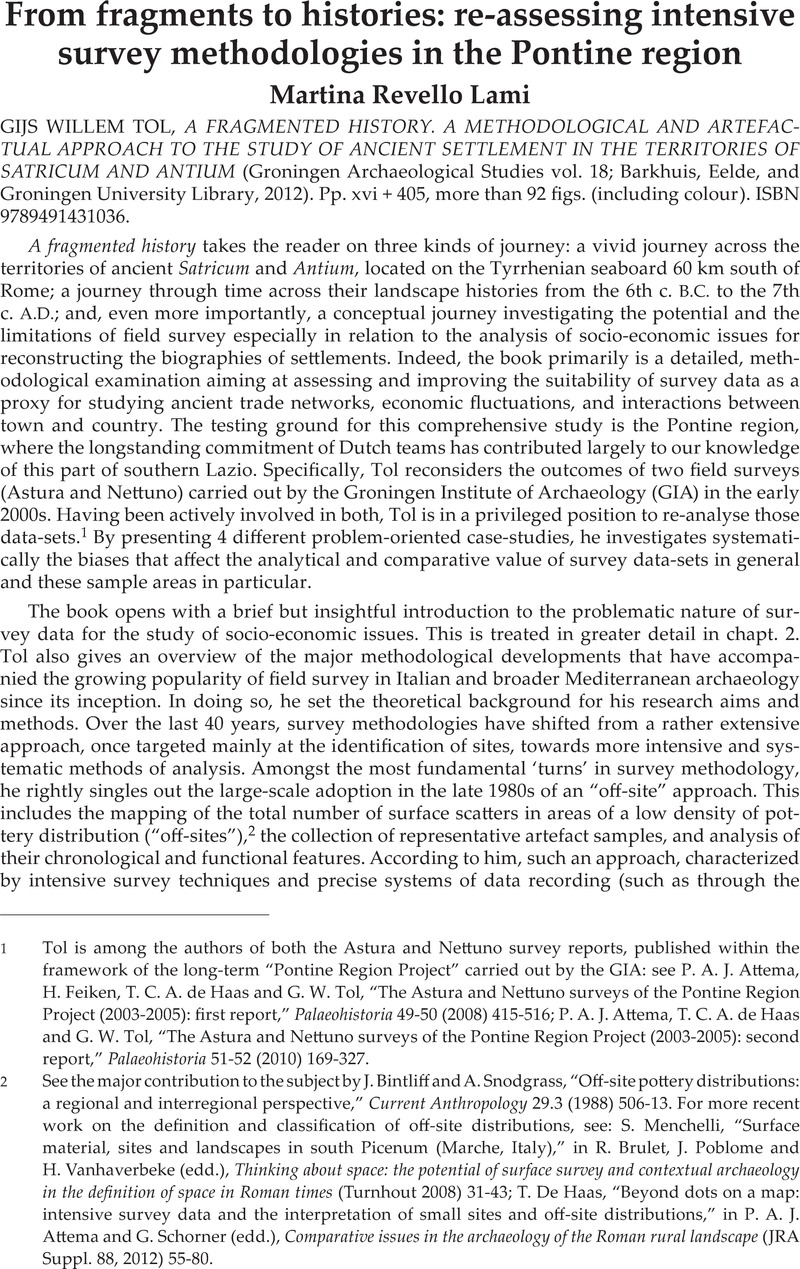No CrossRef data available.
Article contents
From fragments to histories: re-assessing intensive survey methodologies in the Pontine region - GIJS WILLEM TOL, A FRAGMENTED HISTORY. A METHODOLOGICAL AND ARTEFACTUAL APPROACH TO THE STUDY OF ANCIENT SETTLEMENT IN THE TERRITORIES OF SATRICUM AND ANTIUM (Groningen Archaeological Studies vol. 18; Barkhuis, Eelde, and Groningen University Library, 2012). Pp. xvi + 405, more than 92 figs. (including colour). ISBN 9789491431036.
Published online by Cambridge University Press: 27 November 2014
Abstract

- Type
- Reviews
- Information
- Copyright
- Copyright © Journal of Roman Archaeology L.L.C. 2014
References
1 Tol is among the authors of both the Astura and Nettuno survey reports, published within the framework of the long-term “Pontine Region Project” carried out by the GIA: see Attema, P. A. J., Feiken, H., de Haas, T. C. A. and Tol, G. W., “The Astura and Nettuno surveys of the Pontine Region Project (2003-2005): first report,” Palaeohistoria 49–50 (2008) 415–516 Google Scholar; Attema, P. A. J., de Haas, T. C. A. and Tol, G. W., “The Astura and Nettuno surveys of the Pontine Region Project (2003-2005): second report,” Palaeohistoria 51–52 (2010) 169–327 Google Scholar.
2 See the major contribution to the subject by Bintliff, J. and Snodgrass, A., “Off-site pottery distributions: a regional and interregional perspective,” Current Anthropology 29.3 (1988) 506–13CrossRefGoogle Scholar. For more recent work on the definition and classification of off-site distributions, see: Menchelli, S., “Surface material, sites and landscapes in south Picenum (Marche, Italy),” in Brulet, R., Poblome, J. and Vanhaverbeke, H. (edd.), Thinking about space: the potential of surface survey and contextual archaeology in the definition of space in Roman times (Turnhout 2008) 31–43 Google Scholar; Haas, T. De, “Beyond dots on a map: intensive survey data and the interpretation of small sites and off-site distributions,” in Attema, P. A. J. and Schorner, G. (edd.), Comparative issues in the archaeology of the Roman rural landscape (JRA Suppl. 88, 2012) 55–80 Google Scholar.
3 For an overall view, see Gnade, M., Satricum: trent'anni di scavi olandesi (Leuven 2007)Google Scholar.
4 See Vittucci, P. Brandizzi, Antium. Anzio e Nettuno in epoca romana (Rome 2000)Google Scholar.
5 Piccarreta, F., Astura (Florence 1977)Google Scholar.
6 Not surprisingly, the most recent work on the subject has been carried out by the Groningen team; see Attema, P. A. J., de Haas, T. and Tol, G. W., Between Satricum and Antium: settlement dynamics in a coastal landscape in Latium Vetus (BABesch Suppl. 18, 2011)Google Scholar. See also Vittucci, P. Brandizzi, “Considerazioni sulla via severiana e sulla Tabula Peutingeriana,” MEFRA 110.2 (1998) 929–93CrossRefGoogle Scholar, and the still valuable work of Piccarreta (supra n.5).
7 We must be grateful to the authors for including these ceramics in the volume since one crate of the material disappeared from the storerooms shortly after the analysis was carried out.
8 MacDonald, A., “All or nothing at all? Criteria for the analysis of pottery from surface survey,” in Christie, N. (ed.), Settlement and economy in Italy 1500 BC to 1500 AD (Oxford 1995) 25–29 Google Scholar.
9 As is suggested by J. E. Francis, “What’s so rural about the landscape of Roman Crete?” in Attema and Schorner (supra n.6) 91-106.
10 Tol uses the expression “certain site” to indicate a site whose identification as such can be clearly established.
11 On this phenomenon see, e.g., Francovich, R. and Hodges, R., Villa to village: the transformation of the Roman countryside in Italy, c.400-1000 (London 2003)Google Scholar.
12 See the critical statement in Fentress, E. “What are we counting for?” in Francovich, R. and Patterson, H. (edd.), Extracting meaning from ploughsoil assemblages (The Archaeology of Mediterranean Landscapes 5; Oxford 2000) 44–52 Google Scholar.
13 Alcock, S. E. and Cherry, J. F. (edd.), Side-by-side survey: comparative regional studies in the Mediterranean world (Oxford 2004)Google Scholar.
14 Attema, P. A. J., Burgers, G. J. and Leusen, M. Van, Regional pathways to complexity (Amsterdam 2010)Google Scholar.
15 Witcher, R., “Broken pots and meaningless dots? Surveying the rural landscapes in Roman Italy,” PBSR 74 (2006) 39 Google Scholar.




